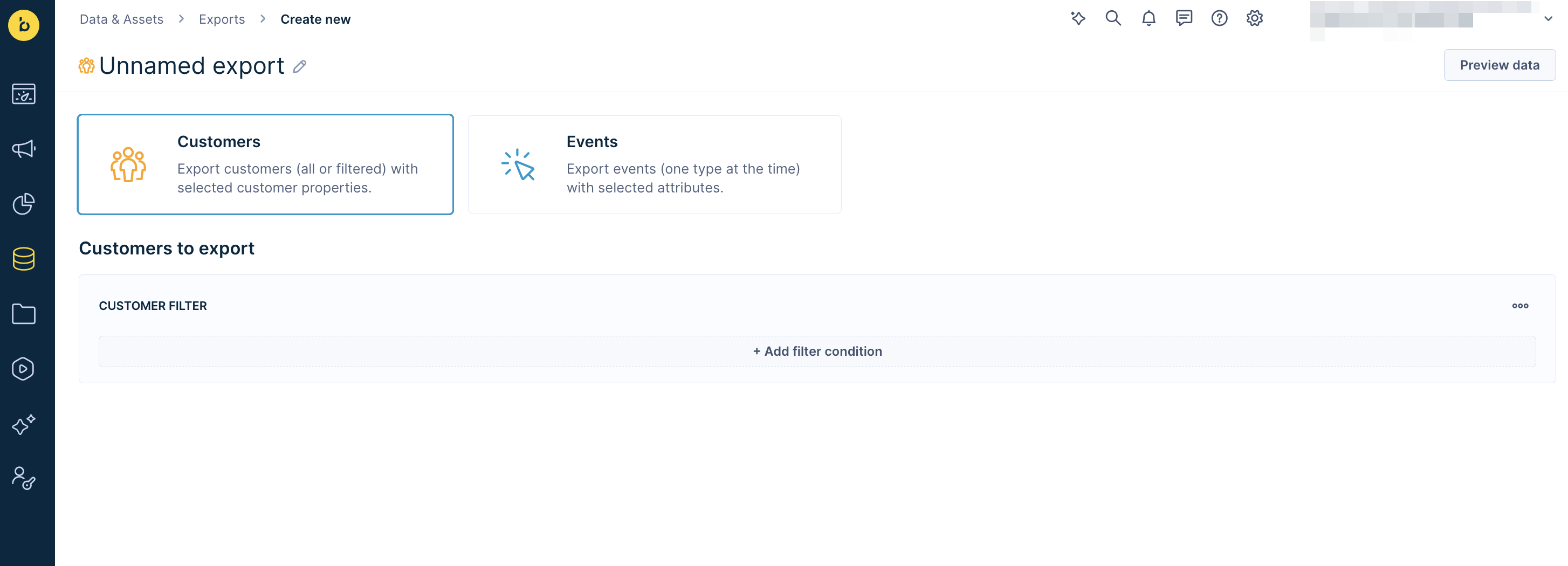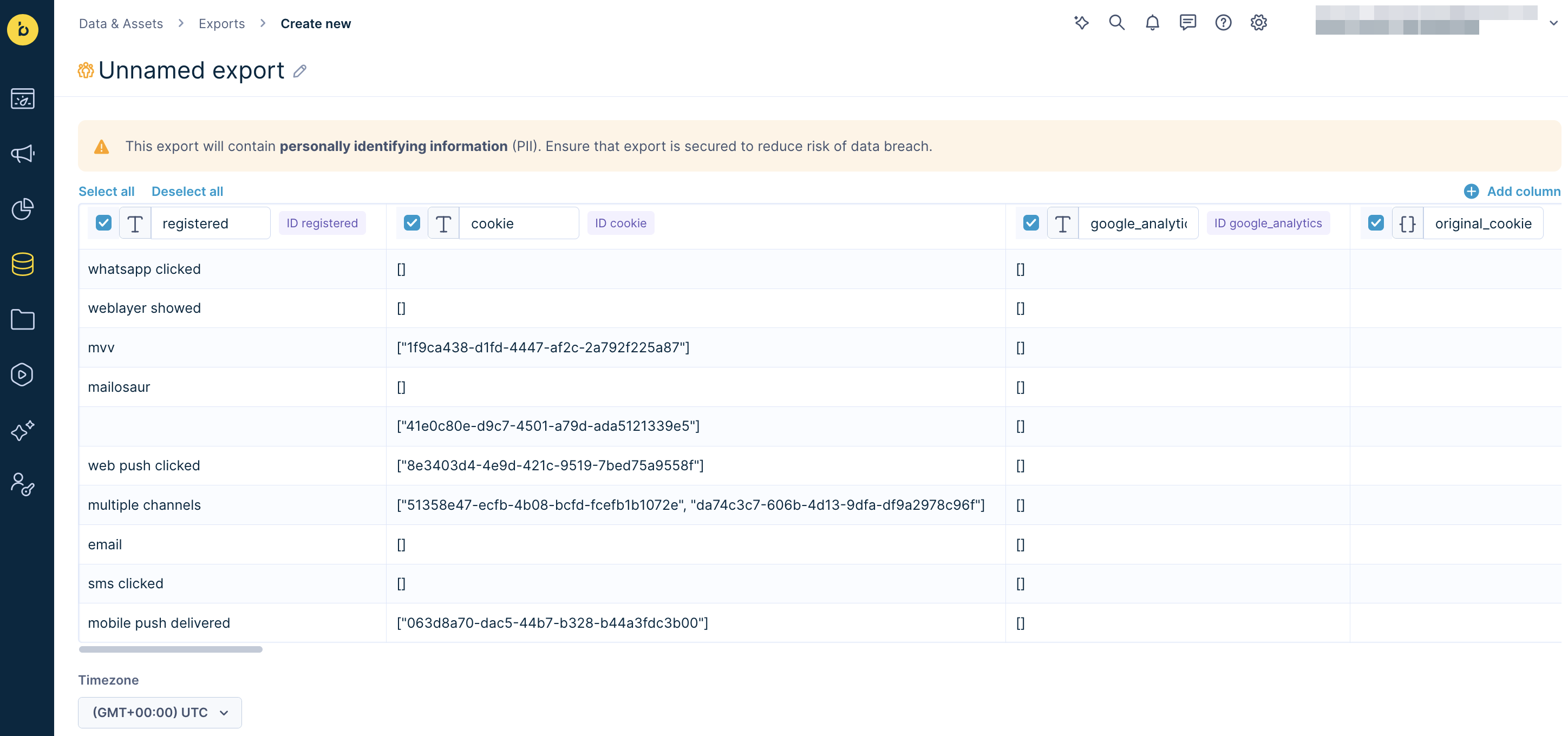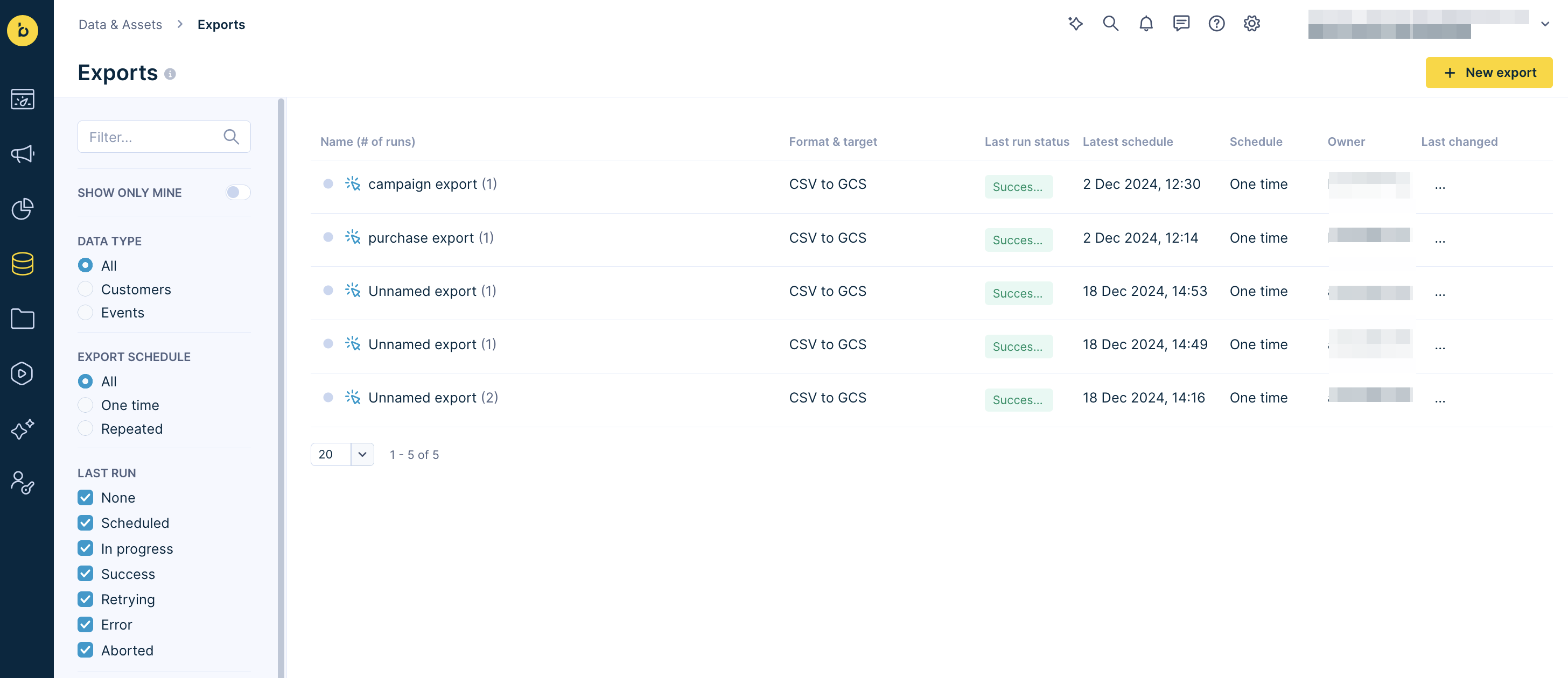Data Exports
You can export raw data (in CSV or JSON format) from Bloomreach Engagement in a custom-defined structure to any file storage using existing integrations (SFTP, Google Cloud Storage, Amazon S3 or Azure Storage).
This enables you to connect with tools or vendors that require bulk data processing, such as:
- Email campaign platforms
- CRMs
- Data warehouses
- Data lakes
Important
Contact your Customer Success Manager to access this feature if it's not available.
You need to have additional permission by the Exports Module Admin and Personal Data Viewer. Project Admin role isn't enough.
Watch this short introductory video about this feature:
Data export overview
Flexibility
You have full flexibility in defining the export output. You can choose:
- Data structure (customers, events)
- Filtering of customer profiles to include in the export
- Attributes to export
- Column name mapping
- Format (CSV, JSON, JSON lines)
- Delimiter (for CSV) and text encoding
- Target storage (SFTP, Google Cloud Storage, Amazon S3 or Azure Storage)
- File naming (custom time-based naming)
Types of data
There are two types of data:
- Static: Raw data, such as customer attributes and event attributes tracked (for example,
email,purchase_item). - Dynamic: Enriched data, such as customer segmentation, event segmentation, aggregates, and calculated expressions (for example,
customer total spent)
Exports triggers
There are three ways to trigger exports:
- Manually
- Scheduled
- Requested via API (for manually triggered imports)
Use case examples
- Load partial data into a unified data warehouse or data lake for further analysis.
- Sync campaign and consent data.
- Enrich data already tracked on the platform.
- Trigger campaigns in offline channels, such as call centers or stores.
Exporting events
When defining the time period for exporting events, remember that events are exported based on their timestamp attribute rather than when they were tracked. These timestamps may differ (for example, an event recorded later with a past timestamp).
During the export, a temporary file is created first. Once the export is completed, this temporary file is renamed to the final filename. Ensure you have the proper permissions to enable file writing to target storage when configuring (SFTP, Google Cloud Storage, Amazon S3 or Azure Storage authorization.
Data export setup
New data export
Access the feature by navigating to Data and Assets > Exports , and click the New export button.
Data source
Select your data source: customers or a specific event type to export.

On the page bottom, you can see all the previous and following steps.
Add filters
Add filter conditions to specify what data you want to export. Find more details on filtering data.
Data structure
Define the data structure, selecting and naming the fields for the export file.

Customize data
Name your export and reorder attributes in the data manager, to meet your needs. For event exports, the timestamp will always be the last column.
Rename columns
Be cautious when adding and renaming columns; having two identical column names will result in an error.
Important
Some exports may contain personally identifiable information (PII). Ensure that exports are secured to minimize the risk of a data breach.
Format and target
Select the desired format, target destination, filename, and security options.

Format
Format specifies how your exported project will look like, based on your personal preference.
- CSV: Determine your delimiter and encoding.
- JSON and JSON Lines: Select your encoding. JSON writes data in a comma-separated format (for example, [{"a":1},{"a":2}...]), while JSON Lines uses a new line for each value (for example, {"a":1} {"a":2}).
To correctly configure and open a CSV file as an MS Excel spreadsheet, refer to this external guide. To preview CSV files, consider using Notepad++ on Windows or Sublime on Mac.
When naming a file, include the file extension (for example, "filename.csv").
Target
Select the destination for your exported data by choosing an available integration (SFTP, Google Cloud Storage, Amazon S3 or Azure Storage).
Set the path to the parent directory and select the file name. Bloomreach Engagement allows for dynamic naming; adding %r after the name will display its timestamp (for example, filename_1589460477.9546165). All other dynamic naming options can be found on this page.
Remember that folders must exist before executing an export, as Bloomreach Engagement will not create them, only files.
Note
With custom software, you can transmit almost any data source via SFTP. Be aware that Bloomreach may not support your specific data source.
Execute export
Schedule execution - one-time or repeated action. Now, you should be ready to finish exporting your project.
Note that the exported data isn't modified by the Bloomreach Engagement platform and contains the data in the form sent to Bloomreach Engagement. Check the data before final processing and validate the format of individual fields.
Viewing and monitoring export runs
In the main Exports screen, you can see all your running, scheduled, and finished exports.

Click on a selected export to view all its individual runs and additional information:
- Scheduled time
- Run duration
- File exported (name of the file)
- Status
- Rows exported/scheduled

Data export limitations
- Only one running export is allowed for each definition.
While you can set up multiple scheduled exports in Bloomreach Engagement, only one can be actively running at a time.
For example, if a scheduled export labeled "All customers" runs every hour but takes 1.5 hours to complete, the 10 am run will begin only after the 9 AM run finishes at 10:30 AM.
- There is a limit of four different exports running simultaneously in Bloomreach Engagement.
- Azure supports exporting up to 48.8GB of data.
- Attempting to export all data from Bloomreach Engagement isn't possible, as it could hit one of the limitations listed above. We recommend exploring other options, such as Bloomreach Engagement BigQuery when attempting to export all data from the platform.
Updated 4 months ago
